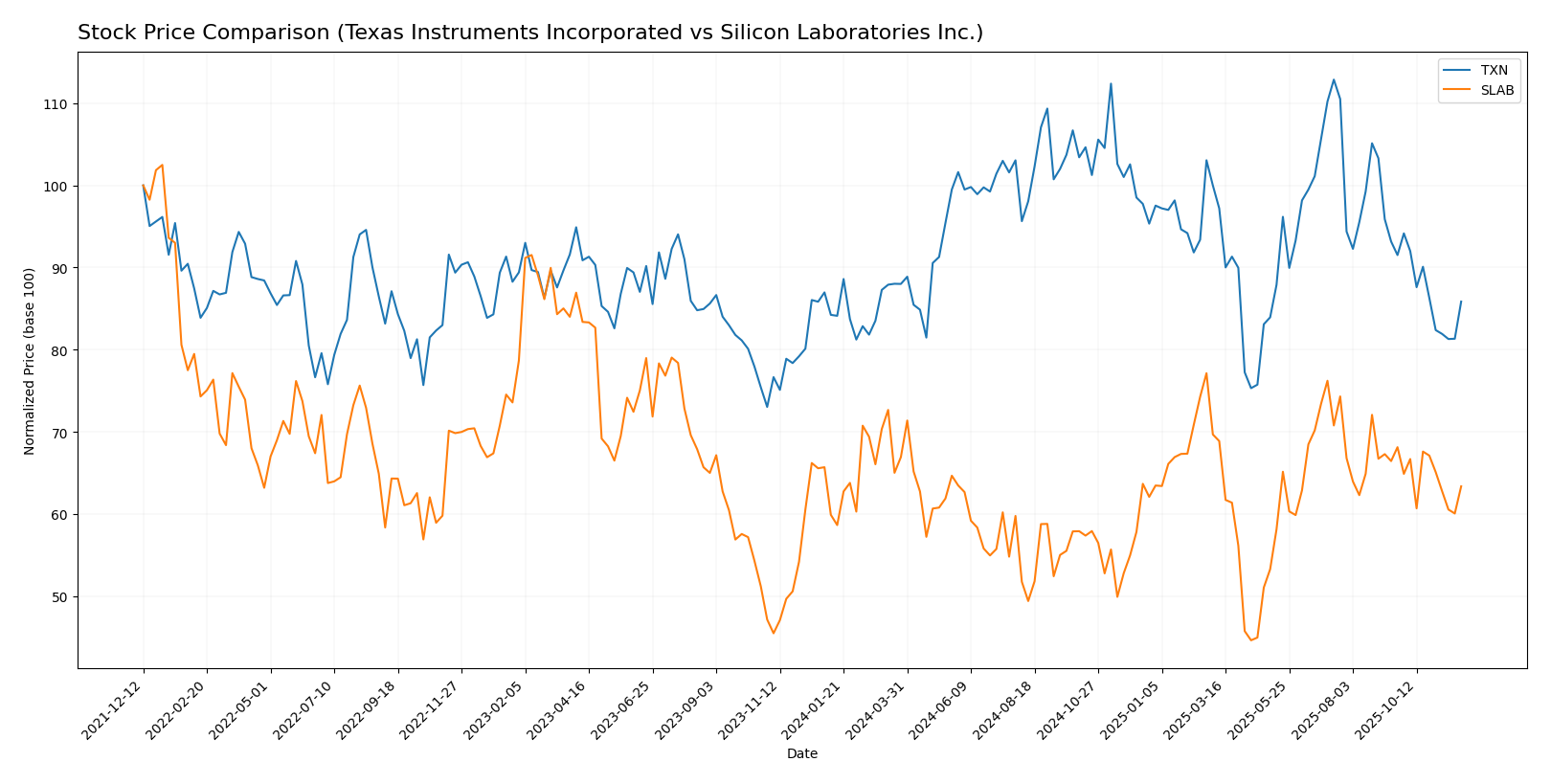In the dynamic world of semiconductors, Texas Instruments Incorporated (TXN) and Silicon Laboratories Inc. (SLAB) stand out as key players, yet they each embody distinct innovation strategies. While both companies operate within the same industry, their market focus diverges—TXN specializes in a broad range of analog and embedded processing solutions, whereas SLAB concentrates on analog-intensive mixed-signal solutions tailored for the Internet of Things (IoT). In this article, I will help you determine which company presents the more compelling investment opportunity.

Table of contents
Company Overview
Texas Instruments Incorporated Overview
Texas Instruments (TXN) is a leading global semiconductor company founded in 1930, headquartered in Dallas, Texas. The company specializes in designing, manufacturing, and selling a wide range of semiconductor products primarily in two segments: Analog and Embedded Processing. The Analog segment focuses on power management solutions and signal chain products, serving markets such as industrial, automotive, and consumer electronics. The Embedded Processing segment offers microcontrollers and digital signal processors, catering to various applications from automotive to communications equipment. With a robust market cap of approximately $152.8B, Texas Instruments has positioned itself as a key player in the semiconductor industry, continually innovating to meet the growing demands of technology.
Silicon Laboratories Inc. Overview
Founded in 1996 and based in Austin, Texas, Silicon Laboratories (SLAB) is a fabless semiconductor company that develops analog-intensive mixed-signal solutions. The company primarily focuses on wireless microcontrollers and sensor products that cater to the Internet of Things (IoT) applications. Their offerings are utilized in a diverse range of sectors, including industrial automation, smart home technology, and medical instrumentation. With a market cap of around $4.19B, Silicon Laboratories emphasizes innovation in connectivity solutions, aiming to leverage the expanding IoT landscape to drive future growth.
Key similarities and differences
Both Texas Instruments and Silicon Laboratories operate within the semiconductor industry, focusing on analog and mixed-signal solutions. However, Texas Instruments has a more extensive product range, including legacy products, whereas Silicon Labs specializes in IoT-related technologies. Additionally, Texas Instruments has a significantly larger market cap and workforce compared to Silicon Laboratories, highlighting its established presence in the market.
Income Statement Comparison
The following table presents a comparison of key income statement metrics for Texas Instruments (TXN) and Silicon Laboratories (SLAB) for their most recent fiscal years. This analysis will provide insight into their financial performance.
| Metric | Texas Instruments (TXN) | Silicon Laboratories (SLAB) |
|---|---|---|
| Market Cap | 153B | 4.19B |
| Revenue | 15.64B | 584.39M |
| EBITDA | 7.54B | -104.92M |
| EBIT | 5.96B | -153.50M |
| Net Income | 4.80B | -191.01M |
| EPS | 5.24 | -5.93 |
| Fiscal Year | 2024 | 2024 |
Interpretation of Income Statement
In the most recent fiscal year, Texas Instruments demonstrated robust performance with a revenue of 15.64B, albeit a decline from the prior year, while Silicon Laboratories faced significant challenges, reporting a revenue of only 584.39M, down from 782.26M in the previous year. TXN’s margins remain strong, with a stable EBITDA reflecting operational efficiency, while SLAB’s negative EBITDA indicates ongoing financial struggles. The contrast in net income highlights TXN’s enduring profitability against SLAB’s substantial losses, underscoring the risks associated with investing in companies facing operational difficulties.
Financial Ratios Comparison
The following table presents a comparative analysis of key financial ratios for Texas Instruments (TXN) and Silicon Laboratories (SLAB).
| Metric | Texas Instruments (TXN) | Silicon Laboratories (SLAB) |
|---|---|---|
| ROE | 28.39% | -17.69% |
| ROIC | 14.75% | -18.15% |
| P/E | 35.63 | -21.53 |
| P/B | 10.12 | 3.81 |
| Current Ratio | 4.12 | 6.15 |
| Quick Ratio | 2.88 | 5.07 |
| D/E | 0.80 | 0.01 |
| Debt-to-Assets | 38.29% | 1.27% |
| Interest Coverage | 10.76 | -126.33 |
| Asset Turnover | 0.44 | 0.48 |
| Fixed Asset Turnover | 1.38 | 4.42 |
| Payout Ratio | 99.92% | 0.00% |
| Dividend Yield | 2.80% | 0.00% |
Interpretation of Financial Ratios
Texas Instruments demonstrates strong profitability with a robust ROE and ROIC compared to Silicon Laboratories, which shows negative returns. TXN’s P/E ratio reflects higher investor expectations, while SLAB’s negative P/E indicates challenges in profitability. The liquidity ratios for both companies are solid, but SLAB’s higher current and quick ratios suggest better short-term financial health. However, SLAB’s lack of dividends and negative interest coverage raises concerns about its financial stability. Overall, TXN appears to be a much stronger investment choice at this time.
Dividend and Shareholder Returns
Texas Instruments (TXN) offers dividends with a yield of 2.8% and a payout ratio of 99.9%, signaling a commitment to returning capital to shareholders. However, the high payout ratio raises concerns about sustainability. In contrast, Silicon Laboratories (SLAB) does not pay dividends, focusing instead on reinvesting in growth and innovation, which may align better with long-term value creation. Both companies engage in share buybacks, but TXN’s dividend strategy may pose risks if cash flows falter, while SLAB’s approach could foster future growth.
Strategic Positioning
Texas Instruments (TXN) holds a significant market share in the semiconductor industry, especially in analog and embedded processing segments. With a market cap of 153B, it competes closely with Silicon Laboratories (SLAB), which specializes in IoT solutions and has a market cap of 4.2B. The competitive pressure is heightened by ongoing technological disruptions in the semiconductor space, necessitating constant innovation and adaptation from both companies to maintain their positions in the market.
Stock Comparison
In this section, I will analyze the weekly stock price movements of Texas Instruments (TXN) and Silicon Laboratories (SLAB) over the past year, highlighting key price dynamics and trading patterns.

Trend Analysis
Texas Instruments (TXN) Over the past year, TXN has experienced a percentage price change of +1.92%. This indicates a bullish trend, albeit one characterized by deceleration, as the stock has shown a notable decrease of -7.85% in recent weeks. The highest price recorded during this period was 221.25, while the lowest was 147.6. The standard deviation of 16.88 suggests a moderate level of volatility in its price movements.
Silicon Laboratories (SLAB) SLAB has demonstrated a stronger price increase of +5.8% over the past year, maintaining a bullish trend, although it too is experiencing deceleration. Recently, SLAB’s price has declined by -4.63%. The highest price it reached was 155.33 and the lowest was 89.82, with a standard deviation of 13.72 indicating lower volatility compared to TXN.
Both stocks are currently facing recent downward pressures despite their overall bullish trends, which may require careful monitoring for potential recovery or further declines.
Analyst Opinions
Recent recommendations for Texas Instruments (TXN) suggest a consensus rating of “Buy” with an overall score of 3. Analysts highlight TXN’s strong return on equity (5) and return on assets (5), indicating robust profitability, despite concerns about its price-to-earnings (2) and price-to-book (1) ratios. In contrast, Silicon Laboratories (SLAB) received a “Sell” rating with an overall score of 1. Analysts point to poor performance in return on equity (1) and return on assets (1) as primary concerns, suggesting it may not be a favorable investment at this time.
Stock Grades
In this section, I will present the latest stock grades for Texas Instruments (TXN) and Silicon Laboratories (SLAB) based on reliable assessments.
Texas Instruments Incorporated Grades
| Grading Company | Action | New Grade | Date |
|---|---|---|---|
| Susquehanna | Maintain | Positive | 2025-10-22 |
| Wells Fargo | Maintain | Equal Weight | 2025-10-22 |
| Truist Securities | Maintain | Hold | 2025-10-22 |
| Rosenblatt | Maintain | Buy | 2025-10-22 |
| Goldman Sachs | Maintain | Buy | 2025-10-22 |
| JP Morgan | Maintain | Overweight | 2025-10-22 |
| Cantor Fitzgerald | Maintain | Neutral | 2025-10-22 |
| Stifel | Maintain | Hold | 2025-10-22 |
| TD Cowen | Maintain | Buy | 2025-10-22 |
| Mizuho | Downgrade | Underperform | 2025-10-20 |
Silicon Laboratories Inc. Grades
| Grading Company | Action | New Grade | Date |
|---|---|---|---|
| Susquehanna | Maintain | Neutral | 2025-08-06 |
| Morgan Stanley | Maintain | Equal Weight | 2025-08-06 |
| Barclays | Maintain | Equal Weight | 2025-08-05 |
| Susquehanna | Maintain | Neutral | 2025-07-22 |
| Stifel | Maintain | Buy | 2025-07-18 |
| Keybanc | Maintain | Overweight | 2025-07-08 |
| Benchmark | Maintain | Buy | 2025-05-27 |
| Needham | Maintain | Buy | 2025-05-14 |
| Benchmark | Maintain | Buy | 2025-05-14 |
| Susquehanna | Maintain | Neutral | 2025-05-14 |
Overall, the trends indicate a stable outlook for both companies, with multiple “Buy” and “Maintain” ratings from various analysts, suggesting confidence in their future performance despite some mixed signals, particularly for Texas Instruments following a recent downgrade.
Target Prices
The consensus target prices for Texas Instruments and Silicon Laboratories indicate positive expectations from analysts.
| Company | Target High | Target Low | Consensus |
|---|---|---|---|
| Texas Instruments (TXN) | 245 | 145 | 190.45 |
| Silicon Laboratories (SLAB) | 165 | 130 | 147.5 |
For Texas Instruments, the current stock price of 168.15 is below the consensus target of 190.45, suggesting potential upside. Similarly, Silicon Laboratories is trading at 127.58, below its consensus of 147.5, indicating a favorable outlook as well.
Strengths and Weaknesses
The following table provides an overview of the strengths and weaknesses of Texas Instruments (TXN) and Silicon Laboratories (SLAB).
| Criterion | Texas Instruments (TXN) | Silicon Laboratories (SLAB) |
|---|---|---|
| Diversification | High | Moderate |
| Profitability | Strong (Net Margin: 31%) | Weak (Net Margin: -3.3%) |
| Innovation | Strong | Moderate |
| Global presence | Extensive | Growing |
| Market Share | High | Moderate |
| Debt level | Manageable (Debt/Equity: 0.80) | Low (Debt/Equity: 0.05) |
Key takeaways indicate that Texas Instruments is well-positioned with strong profitability and extensive global presence, while Silicon Laboratories struggles with profitability despite having low debt levels.
Risk Analysis
In this section, I provide a comparative overview of the risks associated with two companies in the semiconductor industry: Texas Instruments (TXN) and Silicon Laboratories (SLAB).
| Metric | Texas Instruments (TXN) | Silicon Laboratories (SLAB) |
|---|---|---|
| Market Risk | Moderate | High |
| Regulatory Risk | Low | Moderate |
| Operational Risk | Low | High |
| Environmental Risk | Moderate | Low |
| Geopolitical Risk | Low | Moderate |
Both companies face distinct risks, with Texas Instruments exhibiting lower operational and regulatory risks compared to Silicon Laboratories. For instance, SLAB’s high operational risk stems from recent financial struggles, reflected in its negative profit margins, which could impact its stability and market performance.
Which one to choose?
When comparing Texas Instruments (TXN) and Silicon Laboratories (SLAB), TXN presents a stronger financial profile. With a market cap of 171B, TXN boasts robust margins, including a net profit margin of 30.68% and a solid return on equity of 28.39%. In contrast, SLAB has struggled with negative profitability, reflected in its C- rating and a net loss in recent fiscal years. Both companies exhibit bullish stock trends, but TXN’s price trajectory shows more resilience despite recent fluctuations.
For growth-focused investors, TXN appears favorable due to its consistent profitability and solid operational metrics. In contrast, conservative investors seeking stability may find SLAB’s current low valuations appealing, but the associated risks of ongoing losses should not be overlooked. The main risks involve competitive pressures in the semiconductor industry and potential supply chain disruptions.
Disclaimer: This article is not financial advice. Each investor is responsible for their own investment decisions.
Go further
I encourage you to read the complete analyses of Texas Instruments Incorporated and Silicon Laboratories Inc. to enhance your investment decisions:



